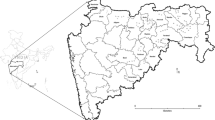Abstract
Infestation of pink bollworm, which is generally considered monophagous continue to grow and spread. This study was conducted to record pink bollworm infestation on four host plants under field and laboratory conditions. Lucerne and tomato were free from pink bollworm damage while okra fruit and cotton flowers and bolls were highly infested. Pink bollworm showed strong affinity with cotton flowers with rosettes first appearing on 15th June and peaking at the end of season. Boll infestation started on 15th July and peaked on 15th October. In okra fruit, first infestation appeared on 30th August and peaked on 30th October. Pink bollworm individuals took 52.698 days to complete their life cycle when reared on okra and 54.775 days on cotton. The morphometric measurement of reared pink bollworm was also calculated.
Similar content being viewed by others
References
Ariela N, Liora SH, Mario R, Roee S, Rami HA (2011) Can tomato be a potential host plant for pink bollworm. World Cotton Research Conference-5, Mumbai, India 258–260
Arshad M, Suhail A (2011) Field and laboratory performance of transgenic Bt cotton containing Cry1Ac against beet armyworm larvae (Lepidoptera: Noctuidae). Pak J Zool 43:529–535
Ashfaq M, Arif MJ, Gogi MD, Suhail A, Sarfraz RM, Zia K (2006) Comparative resistance of transgenic and conventional cotton cultivars against spotted bollworm Earias spp. (Lepidoptera: Noctuidae) on squares, flowers and bolls during the growing season of cotton in Pakistan. Int. Symp. Sustain. Crop Improv. Integ. Manag. University of Agriculture Faisalabad, Pakistan, 14–16 September, pp. 100–1009
Ashfaq M, Noor-ul-Ane M, Zia K, Nasreen A, Mansoor-ul-Hasan (2010) The correlation of abiotic factors and physico-morphic charateristics of Bt (Bacillus thuringiensis) transgenic cotton with whitefly, Bemisia tabaci (Homoptera: Aleyrodidae) and jassid, Amrasca devastans (Homoptera: Jassidae) populations. Afr J Agric Res 5(22):3103–3107
Fife LC (1938) Alternate host plants of the pink bollworm Pectinophora gossypiella (Saund.) in Puerto Rico. J Agric Univ Puerto Rico 22:483–492
Henneberry TJ, Naranjo SE (1998) Integrated management approaches for pink bollworm in the southwestern United States. Integr Pest Manag Rev 3:31–52
Khan ZR, Saxena RC (1998) Host plant resistance to insects. In: Dhaliwal GS, Heinrichs EA (eds) Critical issues in insect pest management. Commonwealth Publishers, New Dehli, pp 118–155
Li Z, Wang X, Zhang Y, Zhang G, Wu L, Chi J, Ma Z (2008) Assessment of genetic diversity in glandless cotton germplasm resources by using agronomic traits and molecular markers. Front Agric China 2:245–252
Patil SB (2003) Studies on management of cotton pink bollworm Pectionophora gossypiella (Saunders) (Lepidoptera: Gelechiidae). Ph. D. Thesis, UAS, Dharwad
Prasad BR, Rahman SJ, Sudarshanam A, Reddy PRR (2018) Assessment of different modules for management of pink bollworm, Pectinophora gossypiella (Saunders) in Bt cotton. J Entomol Zool Stud 6:132–135
Rude CS (1932) Host plant studies of the pink bollworm. J Econ Entomol 25:751–759
Sarwar M (2017) Biological parameters of pink bollworm Pectinophora gossypiella (Saunders) (Lepidoptera: Gelechiidae) A looming threat for cotton and its eradication opportunity. Int J Res Agric For 4:25–36
Shiller I, Noble LW, Fife LC (1962) Host plants of the pink bollworm. J Econ Entomol 55:67–70
Shrinivas SAG, Hanchinal SG, Hurali S, Beldhadi RV (2019) Comparative biology of pink bollworm, Pectinophora gossypiella (Saunders) (Lepidoptera: Gelechiidae) on different hosts. J Entomol Zool Stud 7:1053–1060
Umer M, Atif M, Ahmad M (2019) Successful rearing procedure of Pink Bollworm (Pectinophora gossypiella) Lepidoptera: Gelechiidae on alternate host (Okra). Acta Sci Agric 3:82–85
Van-Esbroeck EG, Bowman DT (1998) Cotton germplasm diversity and its importance to cultivar development. J Cotton Sci 2:121–129
Wu JP, Wu HH, Wan P, Huang MS (2010) Technique for rearing the pink bollworm (Pectinophora gossypiella) with artificial diet. Hubei Agric Sci 47:7
Zinzuvadiya HD, Desai HR, Lakum MB, Rajkumar BK (2017) Biology of pink bollworm, Pectinophora gossypiella Saunders (Lepidoptera: Gelechiidae) on artificial diet under controlled condition. Trends Biosci 10:5363–5371
Author information
Authors and Affiliations
Corresponding author
Ethics declarations
Conflict of interest
The authors declare that they have no conflict of interest.
Additional information
Publisher’s note
Springer Nature remains neutral with regard to jurisdictional claims in published maps and institutional affiliations.
Rights and permissions
About this article
Cite this article
Mushtaq, M.N., Arshad, M., Majeed, S. et al. Demographic and morphometric features of pink bollworm, Pectinophora gossypiella (Saunder) (Lepidoptera: Gelechiidae) on four host plants. Int J Trop Insect Sci 41, 131–135 (2021). https://doi.org/10.1007/s42690-020-00185-w
Received:
Accepted:
Published:
Issue Date:
DOI: https://doi.org/10.1007/s42690-020-00185-w




